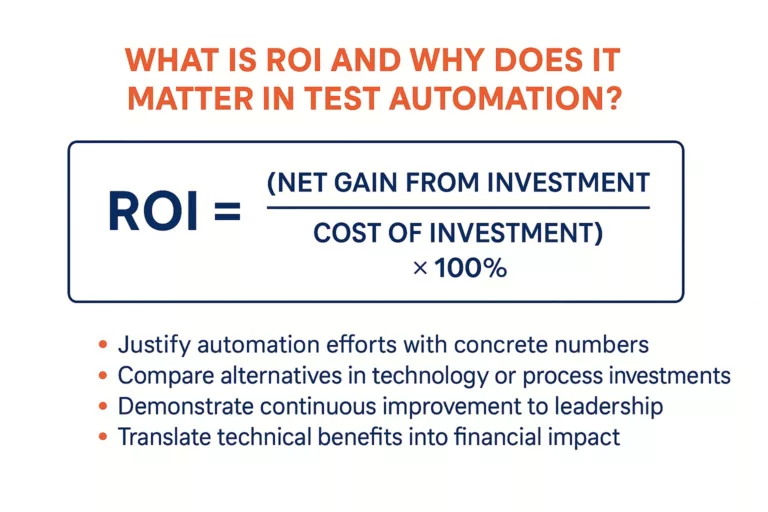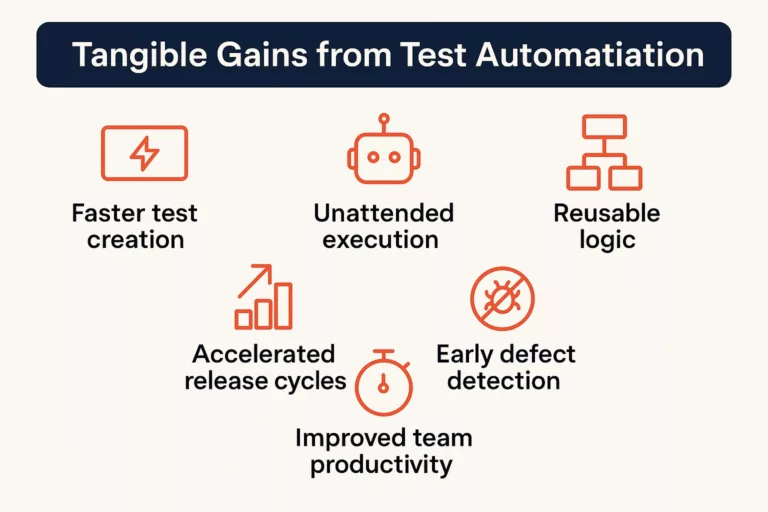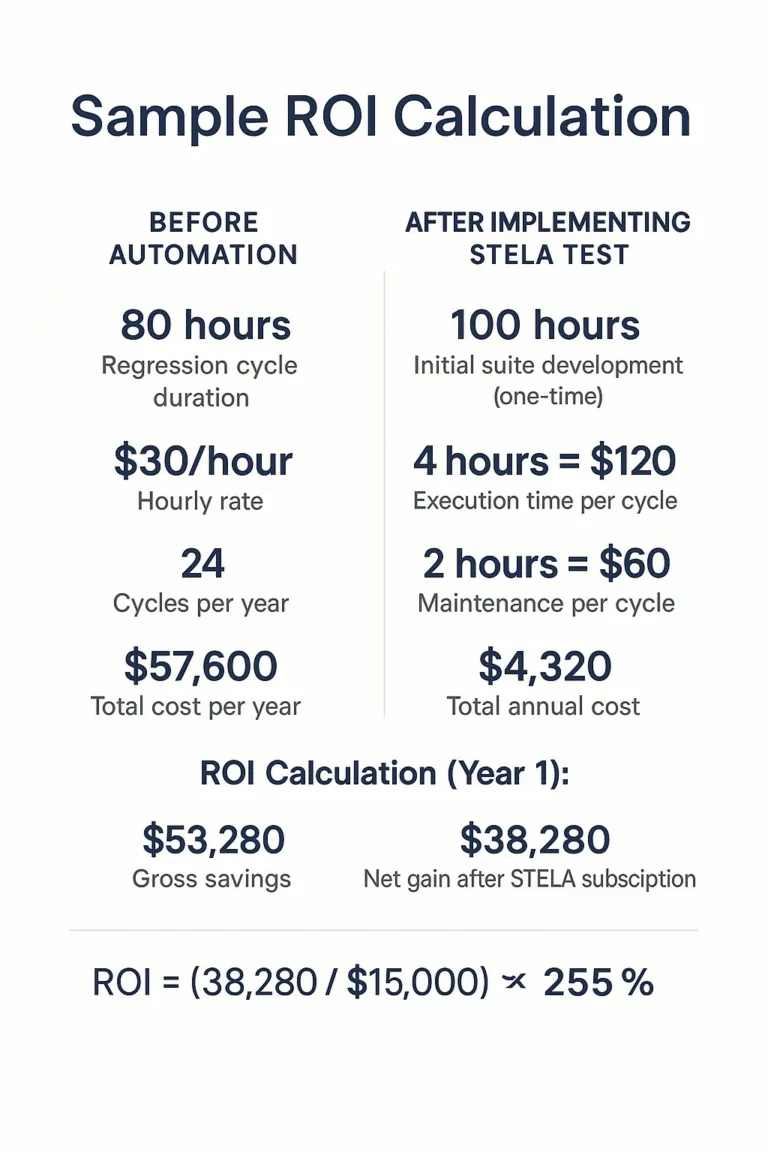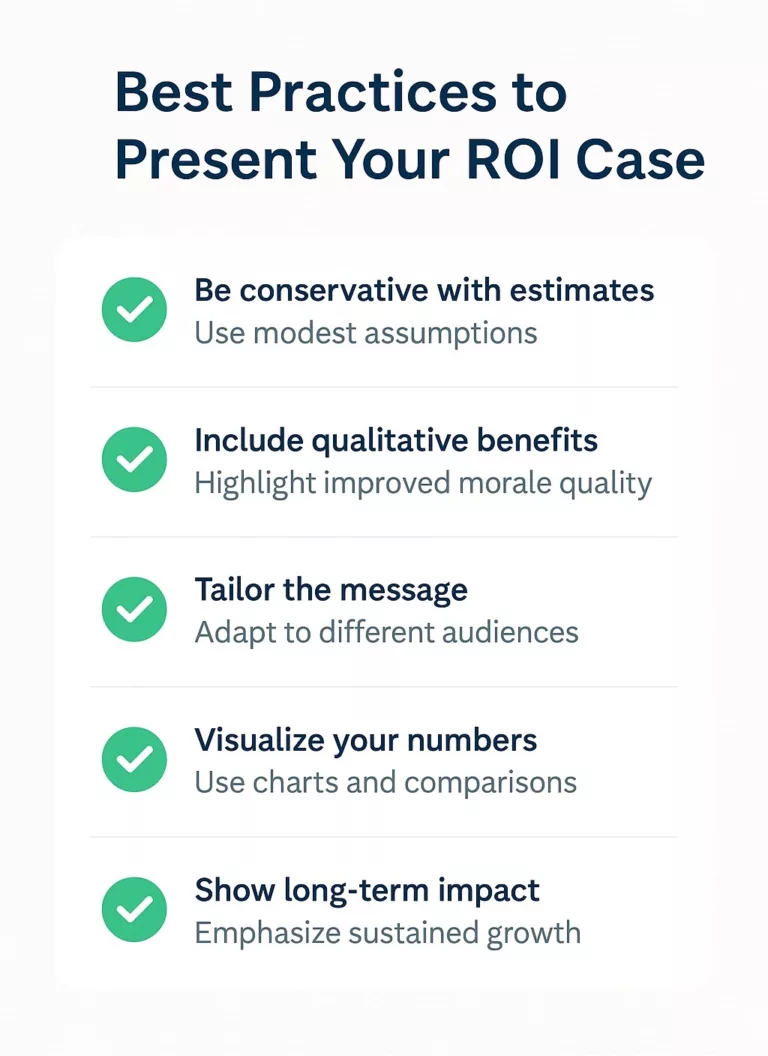In today’s fast-paced digital environment, understanding the automated testing ROI is crucial for organizations aiming to improve software quality and reduce costs. Answering the question “What’s the ROI of test automation?” with real numbers requires a platform like STELA designed to maximize return on investment by enabling faster, more accurate, and scalable testing processes.
This article provides a hands-on guide to help you measure the true ROI of implementing STELA, our no-code automation platform. We’ll show you how to turn time savings, reduced errors, and accelerated releases into hard numbers—so you can justify your automation efforts with confidence.
What Is Automated Testing ROI and Why Does It Matter?
Return on Investment (ROI) is a financial metric that measures the efficiency of an investment. It’s typically expressed as a percentage and calculated with a simple formula:
ROI = (Net Gain from Investment / Cost of Investment) × 100%
In the context of test automation, ROI doesn’t necessarily refer to direct revenue. Instead, it represents cost reductions, improved efficiency, faster time-to-market, and reduced risk. Understanding your ROI allows you to:
- Justify automation efforts with concrete numbers
- Compare alternatives in technology or process investments
- Demonstrate continuous improvement to leadership
- Translate technical benefits into financial impact

Cost Factors to Include in ROI Calculation
To calculate ROI accurately, it’s essential to identify the core components of your investment. With STELA TEST, the cost structure is straightforward and transparent:
- Platform subscription: STELA offers flat-rate licensing, so you can automate without scaling costs linearly.
- Initial setup time: Thanks to STELA’s no-code approach, you avoid long and expensive implementation cycles. Most teams start building tests from day one.
- Training and onboarding: The learning curve is minimal. Non-technical users can master the tool quickly, reducing the need for specialized staff.
- Infrastructure: As a cloud-native SaaS platform, STELA eliminates the need for server maintenance or hardware investments.
These costs are often significantly lower compared to traditional coded automation tools, both in implementation time and maintenance effort.

Tangible Gains from Test Automation
Once you’ve identified the costs, it’s time to outline the value created by implementing STELA TEST. These are the measurable outcomes that drive a strong ROI:
- Faster test creation: Build automation flows visually, without writing code.
- Unattended execution: Run tests in parallel, overnight, or on schedule—zero manual effort required.
- Reusable logic: Define test components once and use them across multiple scenarios.
- Wider test coverage: Automate more test cases and edge scenarios within the same time budget.
- Accelerated release cycles: Shorten QA timelines and deliver features faster.
- Early defect detection: Reduce expensive bugs in production by testing continuously.
- Improved team productivity: Free testers from repetitive tasks and redirect them toward exploratory or strategic testing.
These benefits stack across iterations, delivering compounding returns over time.

How to Boost Automated Testing ROI with STELA
Sample ROI Calculation
Let’s break down a real-world example to understand the potential impact of automating regression testing with STELA:
Before automation:
- Regression cycle duration: 80 hours
- Hourly rate: $30/hour
- Cycles per year: 24
- Total cost per year: 80 × $30 × 24 = $57,600
After implementing STELA:
- Initial suite development: 100 hours (one-time)
- Execution time per cycle: 4 hours = $120
- Maintenance per cycle: 2 hours = $60
- Total cost per cycle: $180
- Total annual cost: $180 × 24 = $4,320
ROI Calculation (Year 1):
- Gross savings: $57,600 – $4,320 = $53,280
- Net gain after STELA subscription (e.g., $15,000): $38,280
- ROI = ($38,280 / $15,000) × 100% ≈ 255%
Note: This scenario doesn’t include other benefits like defect prevention, faster time-to-market, or reduced production incidents—which would make the ROI even higher.

Best Practices to Present Your ROI Case
Once you’ve calculated ROI, the next step is to communicate it effectively to your stakeholders. These tips will help you build a compelling case for adopting STELA TEST across your organization:
- Be conservative with estimates: Use modest assumptions to avoid overpromising. If results exceed expectations, it only strengthens your credibility.
- Include qualitative benefits: Time savings are important, but don’t forget to highlight improved morale, fewer errors, and enhanced software quality.
- Tailor the message: Executives care about cost and business outcomes. QA managers want to hear about efficiency and coverage. Adapt your ROI story to each audience.
- Visualize your numbers: Use charts, tables, and before/after comparisons to make the financial impact clear at a glance.
- Show long-term impact: Emphasize that the return grows over time as automation assets mature and are reused across multiple projects.
Presenting ROI well isn’t just about numbers—it’s about telling a story of value, growth, and transformation.

Frequently Asked Questions
How quickly can I expect to see ROI?
Many teams experience positive ROI within the first few months, especially when automating repetitive regression suites. STELA TEST’s no-code approach shortens setup time and delivers benefits faster than traditional tools.
Is automation with STELA only for large companies?
No. STELA TEST is designed to scale with your business. Whether you’re a startup or an enterprise, our pricing model and tool flexibility make it accessible and efficient for teams of any size.
How do I track ROI over time?
Track metrics like test creation time, execution duration, maintenance effort, and bug rates. STELA TEST also provides built-in reporting tools that make it easy to document these improvements across each release.
What if my implementation or training costs are higher than expected?
Even with a higher upfront investment, automation pays off over time. As test assets are reused and manual hours are reduced, long-term ROI improves dramatically—often within the first 12–18 months.
Final Thoughts
Investing in test automation with STELA TEST is more than a way to save time—it’s a strategic shift toward smarter quality assurance, faster delivery, and measurable business value.
Whether you’re just starting out or looking to scale automation across multiple teams, STELA TEST adapts to your needs with a flat-cost model and no-code flexibility. The return on investment isn’t just theoretical—it’s real, trackable, and proven.
Now is the time to move beyond manual testing limitations and experience what efficient, intelligent automation can do for your organization.
Learn more about the business impact of automated testing from this article from Forbes The Hidden Cost Of Bad Software Practices: Why Talent And Engineering Standards Matter
📅 Ready to see the numbers for yourself?
Schedule a demo and discover how much your organization could gain with STELA TEST.
See how simple it is to automate with STELA
Interested in learning more or having a meeting? Fill out the form below and we will contact you.
